Local TCP / UDP Tests with the Loop-Back at SARA
In this document some results are presented that were obtained with local
TCP and UDP measurements at
SARA, with a loop-back in various locations at
the Cisco 15454. In a number of these tests the performance of the default
used Linux&nbp;2.4.16 Web100 kernel has
been compared with an unmodified V. 2.4.16 kernel. In these tests hosts
gwgsara4 and gwgsara5 have been used that were directly
connected with the Cisco 15454. Both hosts were located in the same VLAN.
TCP Tests
Multiple stream throughput tests between these two hosts have been performed.
Iperf has been used to
generate the traffic, because this tool can easily handle multiple streams. The
topology and other details of these tests are described in the following
sections.
Ethernet Loop-Back
Setup
In these tests the loop-back device has been created at the Gigabit Ethernet
interfaces of the Cisco 15454. Due to the short round-trip times a maximum
TCP window size of 128 Kbyte has been used. The test time was
60 s.
Results
In
the sum of the TCP throughput, taken over all streams, has been
presented with a 3D plot as a function of the TCP sum of the
window size, also taken over all streams, and as a function of the total
# streams. Source and destination window sizes are chosen identical. In
the throughput per stream has been displayed as a function of the TCP
window size. In this plot the data for each # streams are represented by a
separate trace.
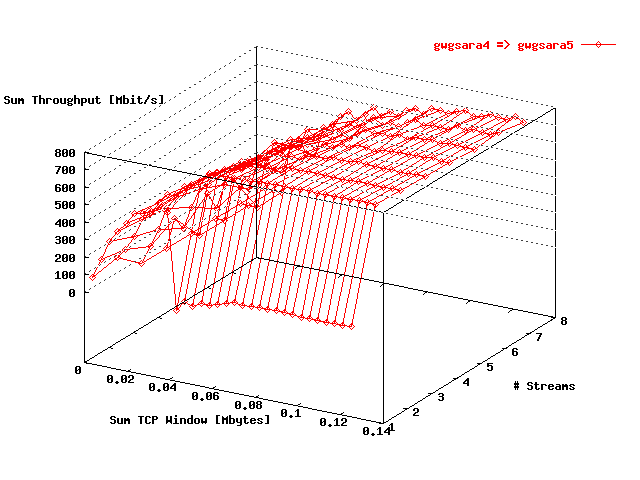
| . |
|
Sum throughput in the direction
gwgsara4 => gwgsara5 over the
Gigabit Ethernet loop-back as a function of the total
window size and the # streams. |
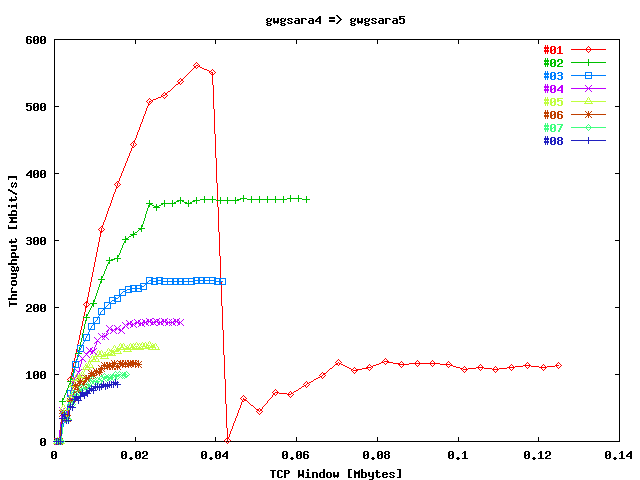
| . |
|
Throughput per stream in the direction
gwgsara4 => gwgsara5 over the
Gigabit Ethernet loop-back as a function of the window
size per stream. |
Conclusions
From the
and
the following conclusions can be drawn:
-
From the sum of the sum of the throughput values
()
there follows that for # streams > 1 the achieved
throughput is independent from the # streams. Probably it will be
limited by the host capacity. Please note that before the memory, and Linux
kernel upgrade the hosts were not capable to achieve higher throughput
values than about 550 Mbit/s.
-
Most clearly from
there follows that for single stream TCP a remarkable dip in the
performance at a window size of about 44 Kbyte. After this dip the
single stream throughput never reaches high values again.
Sonet Loop-Back with Web100 / Unmodified Kernel
Setup
For these tests the loop-back device has been created at the Sonet interface of
the Cisco 15454. The tests were executed both with a
Web100 V. 2.4.16 kernel and an
unmodified V. 2.4.16 kernel. Again a maximum TCP window size of
128 Kbyte had been used, and the test duration had been set to 60 s.
Results
In the following 3D figures the sum of the throughputs has been given as a
function of the sum of the TCP window size and of the # streams.
In
these results are presented in the direction gwgsara4 =>
gwgsara5 with the Web100 kernel
and in
for the reverse direction with the same kernel. In the
and
the data for the same directions as in the previous figures are displayed, but
here an unmodified kernel has been used.

| . |
|
Sum throughput in the direction
gwgsara4 => gwgsara5 over the
Sonet loop-back for a Web100 kernel as a function of the
total window size and the
# streams. |
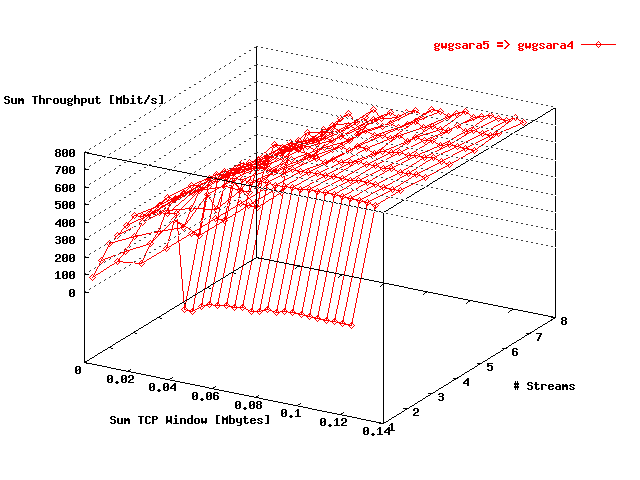
| . |
|
Sum throughput in the direction
gwgsara5 => gwgsara4 over the
Sonet loop-back for a Web100 kernel as a function of the
total window size and the
# streams. |

| . |
|
Sum throughput in the direction
gwgsara4 => gwgsara5 over the
Sonet loop-back for an unmodified kernel as a function
of the total window size and the
# streams. |

| . |
|
Sum throughput in the direction
gwgsara5 => gwgsara4 over the
Sonet loop-back for an unmodified kernel as a function
of the total window size and the
# streams. |
In
the throughput per stream has been given as a function of the TCP
window size for the direction gwgsara4 => gwgsara5,
using a Web100 kernel, while in
the throughput per stream has been shown for the reverse direction. In these
plots are the data for each # streams represented by a separate trace. The
and
are displaying the equivalent data as in the previous two figures, using
an unmodified kernel.

| . |
|
Throughput per stream in the direction
gwgsara4 => gwgsara5 over the
Sonet loop-back for a Web100 kernel as a function of the
window size per stream. |
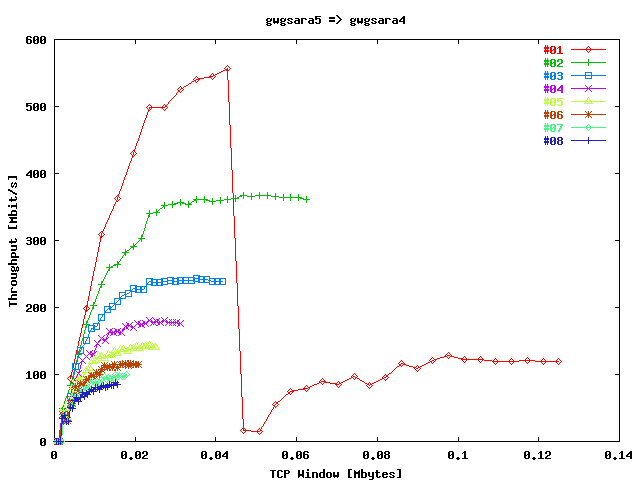
| . |
|
Throughput per stream in the direction
gwgsara5 => gwgsara4 over the
Sonet loop-back for a Web100 kernel as a function of the
window size per stream. |

| . |
|
Throughput per stream in the direction
gwgsara4 => gwgsara5 over the
Sonet loop-back for an unmodified kernel as a function
of the window size per stream. |

| . |
|
Throughput per stream in the direction
gwgsara5 => gwgsara4 over the
Sonet loop-back for an unmodified kernel as a function
of the window size per stream. |
Conclusions
The following can be concluded from the
, ..., :
-
Equivalent behaviour as has been described in the
"Conclusions" subsection from
the "Ethernet Loop-Back" section
could be found here.
-
There are no performance differences between the
Web100 and the unmodified kernel.
-
There are also no performance differences between the two test directions.
UDP Tests
Multiple stream UDP bandwidth tests between the two test hosts
gwgsara4 and gwgsara5 are presented here. Also here
Iperf has been used to
generate the traffic because 1) it is well capable of handling UDP
traffic and 2) this tool can easily handle multiple streams. The topology
of these tests are the same as described in the
"TCP Tests" section. It and the other
test information are described in the following sections.
Ethernet Loop-Back
Setup
Below follows the description of the UDP tests were the loop-back was
located at the Gigabit interfaces. Also here the default
Web100 kernel had been used. The maximum
bandwidth send was 800 Mbit/s. The duration of each test was 60 s.
Results
shows the percentage total packets lost as a function of the total bandwidth
that has been send. The data for each # streams are represented in this
plot by a separate trace.
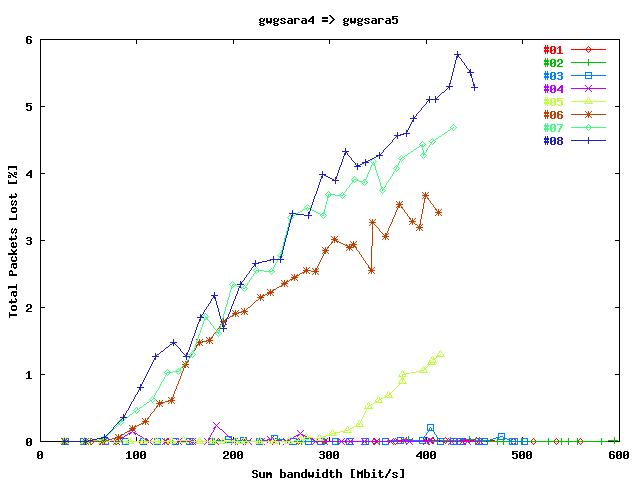
| . |
|
Total packets lost in the direction
gwgsara4 => gwgsara5 over the
Gigabit Ethernet loop-back as a function of the sum of
the bandwidths send. |
Conclusions
From
the following conclusions can be drawn:
-
No more than about 600 Mbit/s could be send. Host effects are probably
responsible for that.
-
No packet lost did occur for the tests with 1, 2, 3 streams.
Sonet Loop-Back with Web100 / Unmodified Kernel
Setup
For these tests the loop-back device has been created at the Sonet interface of
the Cisco 15454. The tests were executed both with a
Web100 and an unmodified V. 2.4.16
kernel. Again the maximum bandwidth send was 800 Mbit/s and the test length
was 60 s.
Results
In the following figures the percentage total packets lost has been given as a
function of the total bandwidth. The data for each # streams are
represented in these figures by a separate plot trace. In
these results are presented in the direction gwgsara4 =&ft;
gwgsara5 with the Web100 kernel
and in
for the reverse direction with the same kernel. In the
and
the data for the same direction as in the previous figures has been displayed,
but here an unmodified kernel has been used.

| . |
|
Total packets lost in the direction
gwgsara4 => gwgsara5 over the
Sonet loop-back for a Web100 kernel as a function of the
sum of the bandwidths send. |
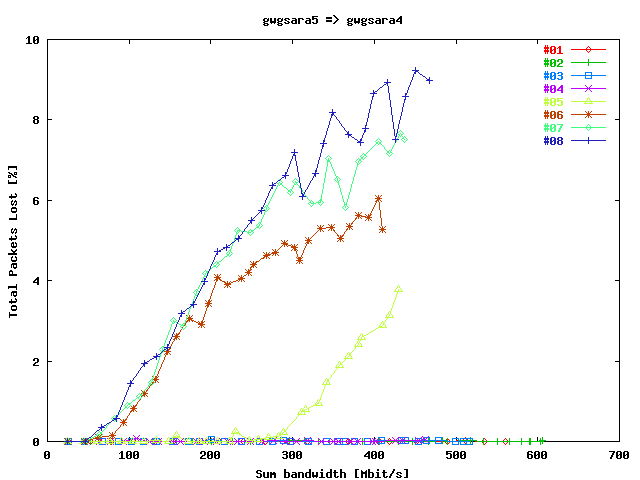
| . |
|
Total packets lost in the direction
gwgsara5 => gwgsara4 over the
Sonet loop-back for a Web100 kernel as a function of the
sum of the bandwidths send. |

| . |
|
Total packets lost in the direction
gwgsara4 => gwgsara5 over the
Sonet loop-back for an unmodified kernel as a function
of the sum of the bandwidths send. |

| . |
|
Total packets lost in the direction
gwgsara5 => gwgsara4 over the
Sonet loop-back for an unmodified kernel as a function
of the sum of the bandwidths send. |
Conclusions
The following can be concluded from the
, ..., :
-
The same characteristics that have been found in the
"Conclusions" subsection from
the "Ethernet Loop-Back" section
could be found here.
-
As in the TCP tests no differences could be found between the tests
in the direction gwgsara4 => gwgsara5 and the
tests in the reverse direction.
General Conclusions
From the TCP and
UDP test results presented here, the
following general conclusions can be given:
-
No differences between the Web100
kernel and the unmodified kernel could be found.
-
The single stream TCP congestion problems are not detected with
UDP traffic type: UDP traffic seems to behave quite
normal.
-
No directional dependent effects could be found.
Other results after the Linux Upgrade to V. 2.4














